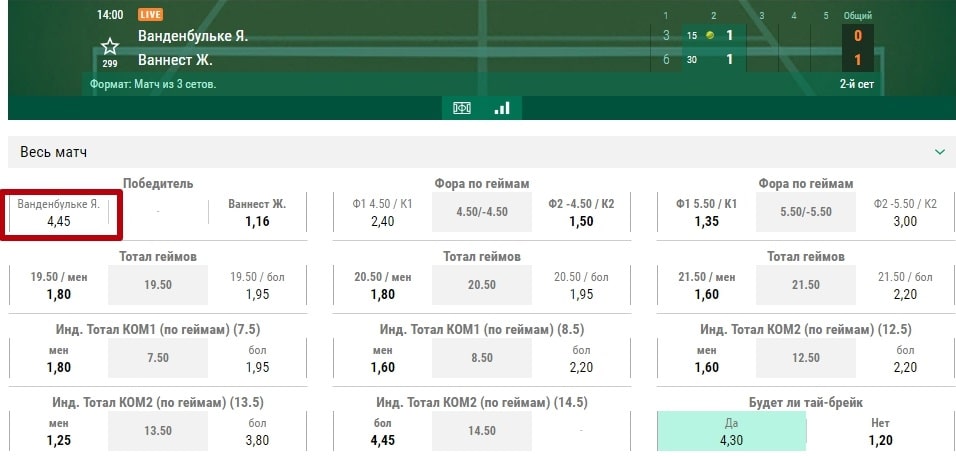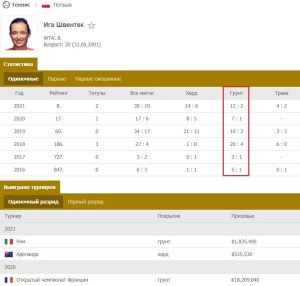
A very popular tennis strategy among experienced players is the reversal betting strategy. U-turns are an integral part of a tennis match where there is at least some kind of struggle. U-turns can be both in the course of one game, and in the whole match: there are situations when in the men's round they win back from the score 0: 2 in parties and win the match.
But reversals are especially common in women's tennis. This is due to the fact that women's tennis is very unstable and unpredictable, it is extremely difficult to predict with confidence the winners of matches and, moreover, tournaments.
Content
- Features of reversal bets
- Betting strategy
- Examples of reversals
- Pros and cons of the strategy
- Conclusion
Features of reversal bets
The optimal and most tasty situation for a bet is when the favorite of the match has lost the first set and loses in the second, but his game is getting better. Those. with a high degree of probability, it will turn out to win back and tip the scales in the match in their favor.
After losing a set in tennis and falling behind in the second in the set, the odds for the favorite to win can be very tempting – from 2 to 7-8.

However, if it is clear that the favorite has not lost heart and has a chance to turn the tide of an unsuccessfully developing match, or is already starting to do so, then you need to bet immediately while the bookmaker offers a tempting odds. It is best to bet on the athlete unfolding the match before the service game.
Read about the features of betting on serve in tennis in a separate review.
At this moment, the odds for his victory in the match or party will be the maximum.
Before betting on a reversal in tennis, it is necessary to study the opponents in the match: their positions in the rating, current form, presence / absence of injuries, recent results, head-to-head meetings, playing on this surface, etc. After matching the athletes according to the above parameters, you can place a bet.
Betting strategy
Consider a reversal betting strategy in tennis. Let's take women's tennis as an example: there is a reversal – a common thing, such situations occur regularly (why – read here).
For example, conditional Venus Williams and Caroline Wozniacki play. The Williams sisters are very combative and seasoned players with whom you need to keep your eye on in any situation and with any score in the match.
Suppose the eldest of the Williams sisters lost the first set of the match 3: 6. It is advisable to find a video broadcast of the match in order to personally observe the ups and downs of the match and to feel the reversal as quickly as possible. The second set began with Wozniacki's serve, which Caroline won. Those. the score in the match 3: 6 and 0: 1 is not in favor of Williams – the situation, it would seem, is very difficult.
But not for a fighter who always believes in himself and fights to the end. With a given score, we observe the behavior and mood of both rivals: how they behave during the rallies, how they react to successful actions and mistakes, whether they complain about the judges, sidelines, spectators, etc.
If the conventional Wozniacki starts to make more mistakes, and Williams, on the contrary, adds in various components of the game, it's time to make a bet. However, you do not need to bet simply at a high coefficient, there must be prerequisites for the bet, here are the following, for example:
- During the match, the leading sportsman had some kind of discomfort, damage;
- The leader of the match has an increased percentage of errors;
- The losing side strongly added and seized the initiative in the match;
- The leading tennis player starts to get tired;
- After several mistakes, the leading tennis player developed self-doubt and began to act stiffly.
In some matches, situations may arise along the way when you can insure your bet – put in the opposite direction at a high coefficient. For example, the lagging behind caught up and came out ahead, and already on his opponent they give a coefficient of more than 2. You can bet on the opposite side to guarantee yourself a profit from the match.
Examples of reversals
Let's consider several situations when reversals beneficial for the bettor took place in the match.
And another example.
In both cases, the clear favorite of the match lost the first set, after which it changed the course of an unimportant match and won a strong-willed victory.
Pros and cons of the strategy
Let's list the advantages of this strategy:
- High odds (most often from 2.5 and higher);
- A reversal is a fairly frequent occurrence, you can regularly select matches suitable for bets;
- A fairly quick calculation of the rate, because it is done during the match;
- A solid increase to the bank in case of a successful entry of the bet.
Now let's list the disadvantages of the strategy:
- High odds are not played too often;
- It is difficult to catch the right moment, put on a reversal at the highest possible coefficient;
- Bookmakers very quickly twist down high odds, more often than not they do not allow betting at high odds.
Conclusion
This is potentially a great strategy, but it requires a very deep knowledge of tennis. It is necessary to know the current form of a large number of players, to be able to quickly navigate the match, to feel the turning point when the initiative passes from one athlete to another.
If you learn how to use the strategy correctly and make thoughtful point bets on reversals, then this strategy can be very profitable, because it is enough to guess just one reversal from 3-4 under a high coefficient of 3 or more to be in the black with proper bank management.


